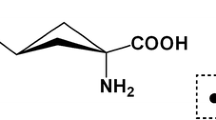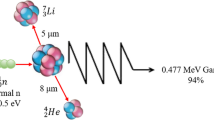Abstract
Purpose
We evaluated the potential of a newly developed 10B-containing α-amino alcohol of p-boronophenylalanine-10B (BPA), p-boronophenylalaninol (BPAol), as a boron carrier in boron neutron capture therapy.
Methods
C57BL mice bearing EL4 tumors received 5-bromo-2'-deoxyuridine (BrdU) continuously via implanted mini-osmotic pumps to label all proliferating (P) cells. After oral administration of L-BPA or D-BPA, or intraperitoneal injection of L-BPAol or D-BPAol, the tumors were irradiated with reactor thermal neutron beams. Some of the tumors were heated at 40 °C for 30 min (mild temperature hyperthermia (MTH)) right before neutron exposure, and/or tirapazamine (TPZ) was intraperitoneally injected 30 min before irradiation. The tumors were then excised, minced, and trypsinized. The tumor cell suspensions thus obtained were incubated with cytochalasin-B (a cytokinesis blocker), and the micronucleus (MN) frequency in cells without BrdU labeling [ =quiescent (Q) cells] was determined using immunofluorescence staining for BrdU. Meanwhile, 6 h after irradiation, tumor cell suspensions obtained in the same manner were used for determining the apoptosis frequency in Q cells. The apoptosis and MN frequency in total (P+Q) tumor cells were determined from the tumors that were not pretreated with BrdU.
Results
Without TPZ or MTH, L- and D-BPAol increased both frequencies markedly, especially for total cells. Although not significantly larger, L-BPA and D-BPAol increased both frequencies slightly more than D-BPA and L-BPAol, respectively. Combination with both MTH and TPZ markedly reduced the sensitivity difference between total and Q cells.
Conclusion
Both L- and D-BPAol have potential as a 10B-carrier in neutron capture therapy, especially when combined with both MTH and TPZ.




Similar content being viewed by others
References
Brown JM, Giaccia AJ (1998) The unique physiology of solid tumors: opportunities (and problems) for cancer therapy. Cancer Res 58:1408–1416
Caswell RS, Coyne JJ, Randolph ML (1980) Kerma factors for neutron energies below 30 MeV. Radiat Res 83:217–254
Coderre JA, Morris GM (1999) The radiation biology of boron neutron capture therapy. Radiat Res 151:1–18
Drayer DE (1986) Pharmacodynamic and pharmacokinetic differences between drug enantiomers in humans: an overview. Clin Pharmacol Ther 40:125–133
Fenech M, Denham J, Francis W, Morley A (1990) Micronuclei in cytokinesis-blocked lymphocytes of cancer patients following fractionated partial-body radiotherapy. Int J Radiat Biol 57:373–383
Griffin RJ, Okajima K, Ogawa A, Song CW (1999) Radiosensitization of two murine tumours with mild temperature hyperthermia and carbogen breathing. Int J Radiat Biol 75:1299–1306
Guo GZ, Sasai K, Oya N, Takagi T, Shibuya K, Hiraoka M (1998) Simultaneous evaluation of radiation-induced apoptosis and micronuclei in five cell lines. Int J Radiat Biol 73:297–302
Honda C, Shiono M, Wadabayashi N, Ichihashi M, Mishima Y, Yoshino K, Kobayashi T, Kanda K, Hori Y, Karashima H (1991) Increased boron uptake by Hamster melanoma using L-isomer 10B-BPA for neutron capture therapy. Res React Inst Kyoto Univ Tech Rep 356:243–248
Kirihata M, Nakano T, Ozaki T, Takagaki M, Ono K (1998) Synthesis and biological evaluation of boron-containing animo alcohols as potential boron carriers on BNCT. Res React Inst Kyoto Univ Prog Rep 1998:174
Kobayashi T, Kanda K, Mishima Y (1989) In situ measurement on 10B concentrations and absorbed dose estimations in human malignant melanoma treated by BNCT. Strahlenther Onkol 165:104–106
Kumanishi A, Kirihata M, Takikawa S, Uehara K, Takagaki M, Ono K (2000) Synthesis and biological evaluation of (R)-(+)-p-boronophenylalaninol. Res Reactor Inst Kyoto Univ Prog Rep 2000:152
Masunaga S, Ono K, Abe M (1991) A method for selective measurement of the radiosensitivity of quiescent cells in solid tumors – combination of immunofluorescence staining to BrdU and micronucleus assay. Radiat Res 125:243–247
Masunaga S, Ono K, Abe, M (1993) The detection and modification of the hypoxic fraction in quiescent cell populations in murine solid tumors. Br J Radiol 66:918–926
Masunaga S, Ono K, Akaboshi M, Nishimura Y, Suzuki M, Kinashi Y, Takagaki M, Hiraoka M, Abe M (1997) Reduction of hypoxic cells in solid tumours induced by mild hyperthermia: special reference to differences in changes in the hypoxic fraction between total and quiescent cell populations. Br J Cancer 76:588–593
Masunaga S, Ono K, Suzuki M, Kinashi Y, Takagaki M (2001a) Radiobiological significance of apoptosis and micronucleation in quiescent cells within solid tumors following γ-ray irradiation. Int J Radiat Oncol Biol Phys 49:1361–1368
Masunaga S, Ono K, Sakurai Y, Takagaki M, Kobayashi T, Kinashi Y, Suzuki M (2001b) Evaluation of apoptosis and micronucleation induced by reactor neutron beams with two different cadmium ratios in total and quiescent cell populations within solid tumors. Int J Radiat Oncol Biol Phys 51:828–839
Meyn RE, Stephens LC, Ang KK, Hunter NR, Brock WA, Milas L, Peters LJ (1993) Heterogeneity in the development of apoptosis in irradiated murine tumours of different histologies. Int J Radiat Biol 64:583–591
Minet E, Michel G, Remacle J, Michiels C (2000) Role of HIF-1 as a transcription factor involved in embryonic development, cancer progression, and apoptosis (review). Int J Mol Med 5:253–259
Nishimura Y, Ono K, Hiraoka M, Masunaga S, Jo S, Shibamoto Y, Sasai K, Abe M, Iga K, Ogawa Y (1990) Treatment of murine SCC VII tumors with localized hyperthermia and temperature-sensitive liposomes containing cisplatin. Radiat Res 122:161–167
Sakurai Y, Kobayashi T (2000) Characteristics of the KUR heavy water neutron irradiation facility as a neutron irradiation field with variable energy spectra. Nucl Instr Meth Phys Res A 453:569–596
Seng F, Ley K (1972) Simple synthesis of 3-amino-1,2,4-benzotriazine-1,4-dioxide. Angew Chem Int Ed Engl 11:1009–1010
Tamemasa O, Goto R, Takeda A, Maruo K (1982) High uptake of 14C-labeled D-amino acid by various tumors. Gann 73:147–152
Thompson CB (1995) Apoptosis in the phathogenesis and treatment of disease. Science 267:1456–1462
Zeman EM, Brown JM, Lemmon MJ, Hirst VK, Lee WW (1986) SR-4233 a new bioreductive agent with high selective toxicity for hypoxic mammalian cells. Int J Radiat Oncol Biol Phys 12:1239–1242
Acknowledgements
This study was supported, in part, by Grants-in-Aid for Scientific Research (B) (13470184) from the Japan Society for the Promotion of Science.
Author information
Authors and Affiliations
Corresponding author
Rights and permissions
About this article
Cite this article
Masunaga, Si., Ono, K., Kirihata, M. et al. Potential of α-amino alcohol p-boronophenylalaninol as a boron carrier in boron neutron capture therapy, regarding its enantiomers. J Cancer Res Clin Oncol 129, 21–28 (2003). https://doi.org/10.1007/s00432-002-0397-3
Received:
Accepted:
Published:
Issue Date:
DOI: https://doi.org/10.1007/s00432-002-0397-3




